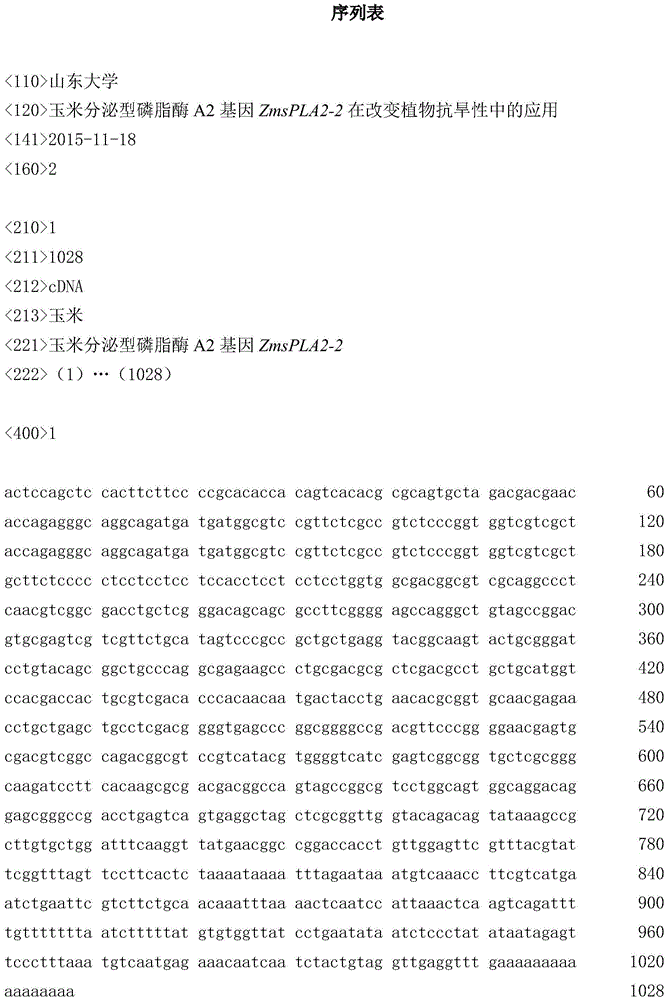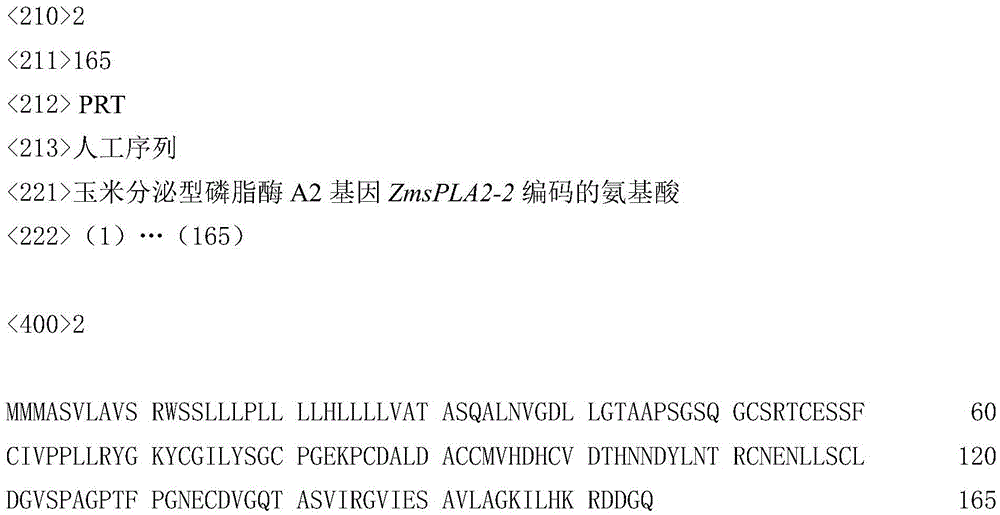Application of maize secretory phospholipase A2 gene ZmsPLA2-2 to changes in plant drought resistance properties
A technology of secreted phospholipase and drought resistance, which is applied in the field of plant bioengineering breeding, and can solve problems such as the lack of understanding of the properties of low-molecular-weight secreted PLA2-encoding genes
- Summary
- Abstract
- Description
- Claims
- Application Information
AI Technical Summary
Problems solved by technology
Method used
Image
Examples
Embodiment 1
[0039] Example 1: Transforming the ZmsPLA2-2 gene to create a drought-resistant inbred line in maize
[0040] 1) Establishment of receptor system
[0041] The main inbred lines used in my country's agricultural production are used as materials, such as inbred seeds of Zheng 58 and Chang 7-2. First soak the seeds with 70% ethanol for 10 minutes, then soak them with 0.1% mercuric chloride for 10-15 minutes, and then wash them with sterile water for 3-5 times. After sterilization, put the seeds in a sterile Erlenmeyer flask to germinate, put a small amount (30-40ml / 250ml Erlenmeyer flask) of sterile water in the bottle, seal it and place it under dark conditions (23-30°C) for 1-2 days. sky. After germination (lubai), the seeds were placed on MS medium and continued to germinate under dark conditions. When the germ elongates to 3-4 cm, the coleoptile and 2-3 young leaves are peeled off to expose the stem tip growth cone for Agrobacterium-mediated maize genetic transformation. ...
Embodiment 2
[0063] Example 2: Transducing the ZmsPLA2-2 gene to create new drought-tolerant cotton materials
[0064] 1) Construction of ZmsPLA2-2 gene transformation vector and Agrobacterium transformation
[0065] The ZmsPLA2-2 gene coding frame was fused with the stress-inducible promoter Prd29B or the constitutive promoter PCaMV35S, and the fusion gene was inserted into the plant expression vector pCambia1300-PCaMV35S::bar by conventional gene recombination technology to generate the transformation vector pCambia1300- PCaMV35S::ZmsPLA2-2-PCaMV35S::bar and pCambia1300-Prd29B::ZmsPLA2-2-PCaMV35S::bar. Then the competent cells of Agrobacterium tumefaciens strain LBA4404 were prepared by calcium chloride method. Take 50 μl of competent cell suspension, add 1 μg of recombinant plasmid DNA at room temperature, mix well, and ice-bath for 30 minutes, place in liquid nitrogen for quick freezing for 1 minute, and after incubating at 37°C for 3 minutes, add 1ml of YEP medium and shake well, sha...
Embodiment 3
[0077] Example 3: Transducing the ZmsPLA2-2 gene to create a new drought-resistant material of Poa annua
[0078] Bluegrass (Poapratensis L.) is one of the most important turfgrass species in temperate regions. Because of its beautiful color, strong cold resistance, shade tolerance, and pruning resistance, it is widely used as a lawn grass in the northern and central regions of my country, as well as in some cool areas in the south. Bluegrass grass also has its own shortcomings, such as weak drought resistance, poor high temperature resistance, intolerance to heat, and susceptibility to pests and diseases. Its growth stops in midsummer, and even some of them die. These disadvantages have greatly restricted the widespread use of bluegrass in hot summer areas. Because Poa annua has the characteristic of parthenogenesis, it is difficult to improve these unfavorable traits by conventional breeding techniques, and the success rate is low. Therefore, the work of breeding new variet...
PUM
 Login to View More
Login to View More Abstract
Description
Claims
Application Information
 Login to View More
Login to View More - R&D
- Intellectual Property
- Life Sciences
- Materials
- Tech Scout
- Unparalleled Data Quality
- Higher Quality Content
- 60% Fewer Hallucinations
Browse by: Latest US Patents, China's latest patents, Technical Efficacy Thesaurus, Application Domain, Technology Topic, Popular Technical Reports.
© 2025 PatSnap. All rights reserved.Legal|Privacy policy|Modern Slavery Act Transparency Statement|Sitemap|About US| Contact US: help@patsnap.com


